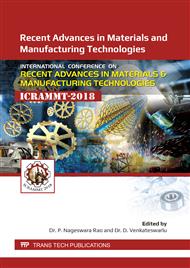[1]
Ramesh CS, Jagadeesh SK and Keshavamurthy R (2011) Solidification Studies on Sand Cast Al 6061–SiCp Composites. Journal of Alloys and Compounds, 509S:S371-S374.
DOI: 10.1016/j.jallcom.2011.01.077
Google Scholar
[2]
Muthazhagan C, Babu AG, Bhaskar GB and Rajkumar K (2013) Influence of Graphite Reinforcement on Mechanical Properties of Aluminium-Boron Carbide Composites. Advanced Material Research, 845:398-402.
DOI: 10.4028/www.scientific.net/amr.845.398
Google Scholar
[3]
Nagaral M, Bharath V and Auradi V (2013) Effect of Al2O3 Particles on Mechanical and Wear Properties of 6061Al Alloy Metal Matrix Composites. Journal of Material Science and Engineering, 2(1):1-4.
DOI: 10.4172/2169-0022.1000120
Google Scholar
[4]
Rajeshwari P and Dey TK (2016) Finite Element Modelling and Experimental Investigation on Effective Thermal Conductivity of AlN (Nano) Particles Reinforced HDPE Polymer Nanocomposites. Thermochimica Acta, 638:103-112.
DOI: 10.1016/j.tca.2016.06.016
Google Scholar
[5]
Rahman MH and Rashed HMMA (2014) Characterization of Silicon Carbide Reinforced Aluminium Matrix Composites. Procedia Engineering, 90:103-109.
DOI: 10.1016/j.proeng.2014.11.821
Google Scholar
[6]
Radhika N, Subramanian R and Prasat SV (2011) Tribological Behaviour of Aluminium/Alumina/Graphite Hybrid Metal Matrix Composite using Taguchi's Techniques. Journal of Mineral and Materials Characterization Engineering, 10(5):427-443.
DOI: 10.4236/jmmce.2011.105032
Google Scholar
[7]
Zhang P, Xiao X and Ma ZW (2016) A Review of the Composite Phase Change Materials: Fabrication, Characterization, Mathematical Modelling and Application to Performance Enhancement. Applied Energy, 165:472-510.
DOI: 10.1016/j.apenergy.2015.12.043
Google Scholar
[8]
Sudindra S and Kumar AC (2013) Studies on Al6061/Al2O3 and Graphite Hybrid Metal Matrix Composites. International Journal of Metallurgy and Material Science Engineering, 3(3):35-42.
Google Scholar
[9]
Venkatesan A, Gopinath VM and Rajadurai A (2005) Simulation of Casting Solidification and its Grain Structure Prediction using FEM. Journal of Material Processing Technology, 168:10-15.
DOI: 10.1016/j.jmatprotec.2004.09.090
Google Scholar
[10]
Jagadeesh SK, Ramesh CS, Mallikarjuna JM and Keshavamurthy R (2010) Prediction of Cooling Curves during Solidification of Al 6061–SiCp based Metal Matrix Composites using Finite Element Analysis. Journal of Materials Processing Technology, 210:618-623.
DOI: 10.1016/j.jmatprotec.2009.11.010
Google Scholar
[11]
Zhang D and Nastac L (2014) Numerical Modelling of the Dispersion of Ceramic Nanoparticles during Ultrasonic Processing of Aluminium-based Nanocomposites. Journal of Materials Research and Technology, 3(4):296-302.
DOI: 10.1016/j.jmrt.2014.09.001
Google Scholar
[12]
Hohe J, Fliegener S, Findeisen C, Reiser J, Widak V and Rieth M (2016) Numerical Exploration into the Potential of Tungsten Reinforced CuCrZr Matrix Composites. Journal of Nuclear Materials, 470:13-29.
DOI: 10.1016/j.jnucmat.2015.11.056
Google Scholar
[13]
Li M, Ghosh S, Richmond O, Weiland H and Rouns TN (1999) Three Dimensional Characterizations and Modelling of Particle Reinforced Metal Matrix Composites: Part I Quantitative Description of Microstructural Morphology. Material Science and Engineering, A265:153-173.
DOI: 10.1016/s0921-5093(98)01132-0
Google Scholar
[14]
Shorowordi KM, Laoui T, Haseeb ASMA, Celis JP and Froyen L (2003) Microstructure and Interface Characteristics of B4C, SiC and Al2O3 Reinforced Al Matrix Composites: A Comparative Study. Journal of Materials Processing Technology, 142:738-743.
DOI: 10.1016/s0924-0136(03)00815-x
Google Scholar
[15]
Cetin A and Kalkanli A (2009) Numerical Simulation of Solidification Kinetics in A356/SiCP Composites for Assessment of As-Cast Particle Distribution. Journal of Materials Processing Technology, 209:4795-4801.
DOI: 10.1016/j.jmatprotec.2008.12.007
Google Scholar
[16]
Lelito J, Zak PL, Shirzadi AA, Greer AL, Krajewski WK, Suchy JS, Haberl K and Schumacher P (2012) Effect of SiC Reinforcement Particles on the Grain Density in a Magnesium-based Metal-Matrix Composite: Modelling and Experiment. Acta Materialla, 60:2950-2958.
DOI: 10.1016/j.actamat.2012.01.058
Google Scholar
[17]
Barekar N, Tzamtzis S, Dhindaw BK, Patel J, HariBabu N and Fan Z (2009) Processing of Aluminum-Graphite Particulate Metal Matrix Composites by Advanced Shear Technology. Journal of Materials Engineering Performance, 18(9):1230-1240.
DOI: 10.1007/s11665-009-9362-5
Google Scholar
[18]
Saheb DA (2011) Aluminium Silicon Carbide and Aluminium Graphite Particulate Composites. ARPN Journal of Engineering and Applied Science, 6(10):41-46.Kosti S and Pathak P (2018) Genetic Algorithm based Finite Difference Simulation of Solidification Process for MMC's. Materialstoday Proceedings, 5:8271-8291.
DOI: 10.1016/j.matpr.2017.11.518
Google Scholar
[19]
Weiss D, Grassi J, Schultz B and Rohatagi P (2011) Ablation of Hybrid Metal Matrix Composites. American Foundry Society Proceeding, pp.1-7.
Google Scholar
[20]
Shabani MO and Mazahery A (2012) Artificial Intelligence in Numerical Modelling of Nano Sized Ceramic Particulates Reinforced Metal Matrix Composites. Applied Mathematical Model, 36:5455-5465.
DOI: 10.1016/j.apm.2011.12.059
Google Scholar
[21]
Shabani MO and Mazahery A (2013) Application of GA to Optimize the Process Conditions of Al Matrix Nano-Composites. Composites Part B: Engineering, 45:185-191.
DOI: 10.1016/j.compositesb.2012.07.045
Google Scholar
[22]
Rohatagi PK (1993) Metal Matrix Composites. Defence Science Journal, 43(4):323-349.
Google Scholar
[23]
Kosti S and Malvi CS (2018) Cumulative influence of nanoparticles on MMCs' time–temperature history curve. Nanomaterials and Energy, 7(1):1-10.
DOI: 10.1680/jnaen.17.00011
Google Scholar


